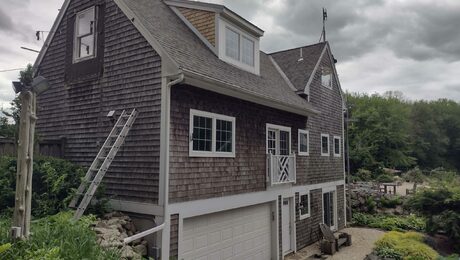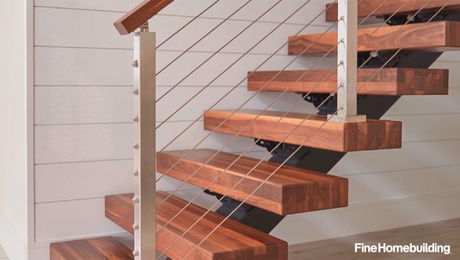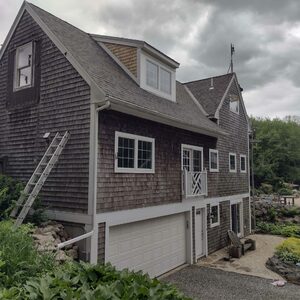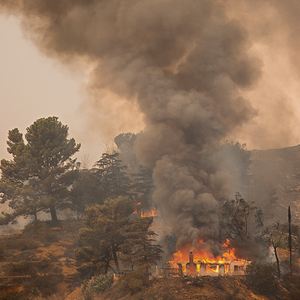Hello to all
I have been lurking for some time, this is my first post.
We will be framing KD 2×10 floor joist into 14 inch LVL.
How high above LVL should I raise 2×10 to allow for differential shrinkage, if any?
Thank to any who respond,in advance.
ROSY548



















Replies
What is the moisture content of the 2x10's? What will the eventual MC of the framing lumber (finished house) be?
Until you have some rough numbers for either I don't know how to get close enough.
Jon Blakemore
Like Jon said, the differential moisture content is really what you need to consider. LVL's do expand and contract with changes in moisture, unlike plywood which has grain running at opposing angles to restrict movement. Assuming everything seems dry, we usually just run all the tops at the same height.
Mike
A 9" 2x10 against an 14" LVL...where you putting that 5" difference?
Rosy is putting the difference underneath. For 2 reasons, 1st, it is the most common place to put it. sometimes it is placed protruding above the floor with a wall situated on top of it. (most often in a exterior wall situation) 2nd you can tell by her post. She asks how far above the LVL to align joists to allow for shrinakge. indicating to me that she wants top to be flush in the end.
To Rosy, i go along with all things being equal, make it flush. even if you were to get a 1/4"shrinkage it should be across the width of the joist and not the top portion only. bringing the top down 1/8 th and the bottom up 1/8th. If your concerned about the joist then settling in the the hangers the 1/8 " bringing everything down 1/4" then use pressure blocks instead of hangers. ( That's what we use anyways the few times we use dimensional lumber as floor joists) But 1/4" shrinkage is a fair bit, most likely you'll end up with about about an 1/8" if you're dealing with lumber with a low moisture content.
Nails .
You are correct,flush on top is the plan. This is a second story addition with a combo of LVL,open web trusses(by Open Joist,only floor truss approved in Elmhurst IL. due to fire codes),and dim. lumber. In the past we always held the tops flush,but I recall reading something about diff.shrinkage and thus the question. I guess it may be time to invest in a moisture meter.
Thanks again to you and all others.
Rosy548 PS I think I filled out my bio correctly but if not,I'am a 55 YO male and operate a small full service remodeling and general contracting company in suburban Chicago
sorry for sticking my hammer in my mouth. I never even bothered to read your bio. I was trying not be discriminatory by assuming all males work construction. Instead I was lazy and didn't look at your bio. sorry mate :)
I just ripped a leftover piece of 2x10 SPF I have had in my heated shop for the last 12 months.
I remember working with the 2x10s at framing time, and they all were quite close to 9-1/4 width, like they should be.
The one I ripped measured 9 and a scant 16th.
I would recommend lowering your LVLs 1/4" where sawn lumber comes into hangers on both sides.
Why fool around with a moisture meter when you know there should be some drop? A void is a void. To me, it is better to know that your LVL location will never be humped, than to calculate shrinkage and try to design the drop so that everything flushes up at full moisture equilibrium.
some of these responses are just too scientific. i'd hold the 2x10s up an eighth and let her rip. It is framing, not furniture work
Welcome to the Taunton University of Knowledge FHB Campus at Breaktime. where ... Excellence is its own reward!
piffin, I'd go along with the 1/8"
Find a moisture meter and check out what the 2x's read.
Some mills dry their stock to below 19% and others just to almost 19%.
Some lumberyards shed their lumber, some rely on a paper wrap, some set the unwrapped material out in the yard....so wetness may vary and shrinkage of a 1/4" is possible.
If beam and joist are of similar moisture content...even up the installation.
If they differ by a lot....adjustment may be prudent.
Factor in your heating/humidity consideration in the drydown and basement vs. crawlspace humidity.
Don't get too anal about this either!
..................Iron Helix
Rosy,
I'm sure someone will disagree and tell me that I should be carrying a moisture meter in my tool best for absolute precision, but..... there's a reason why it's called a rough frame.
When we have conventional framing lumber flush framed to engineered lumber we set the LVL 1/4" lower than the top of the joists to allow for shrinkage. Never had a problem.
EDIT: Sorry Piff, shoulda read through the rest of responses before I replied. Got kinda frustrated and didn't finish. Just nail 'er sailor!
Edited 5/8/2005 11:53 pm ET by dieselpig
Maybe I should have added an example from a house I supplied material to in June 1990.
Lumber for the floor system was ordered via Geaogia Pacific on a truckload basis. The builder had the foundation/basement in and was ready.
The truck was setting on our lot at 7 am, the units of 2x10 were forked off the semi and onto our delivery truck and straight to the house site.
The day after Thanksgiving of 1990 I receive a call from the builder and we meet at the house to see why walls and floor are shifting and drywall is cracking.
The GP rep also arrives and the owner soon hires a lawyer.
Final conclusion....the lumber was stamped KD #1SYP, but the mill had never run it through the kiln. Shipping weight logs at loading time told the story and GP anted up about $50K for repairs.
That was when I bought a moisture meter and made a habit if checking out suspicious looking units for excessive moisture when they came in from the supplier/shipper.
In the following 12 years after that I probably returned over 20 different assorted units due to high moisture content. Many as a result of being stored in the open at the warehouse.
I do know that the man that owns the house in the story still will not speak to me.
Overly picky? Maybe. .............Iron Helix
I generally gauge it by instinct, weight, and size as delivered. one word to make clear to everyone, the standard for KD is to dry to 19% on surface of the lumber, not wholly, so It can easily be 24% or so on the inside of any delivery piece. 16% is a better standard to actuyally build with but that is so variable since the weather changes twenty times while the structure gets raised and dryed in.
Welcome to the Taunton University of Knowledge FHB Campus at Breaktime. where ... Excellence is its own reward!
Second the motion.............
Instinct through experiences causes those red flags to be thrown in ones mind as the product passes into the hands.
Paying attention to those signals and understanding how to differentiate what really matters separates the better professional from the run of the mill.
...............Iron Helix